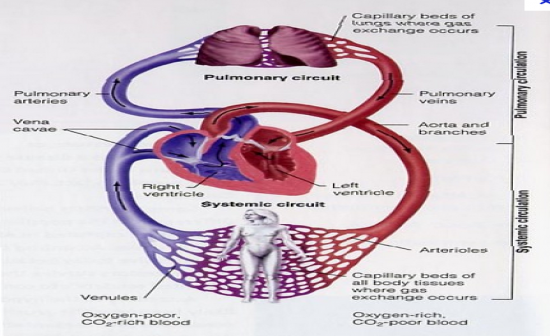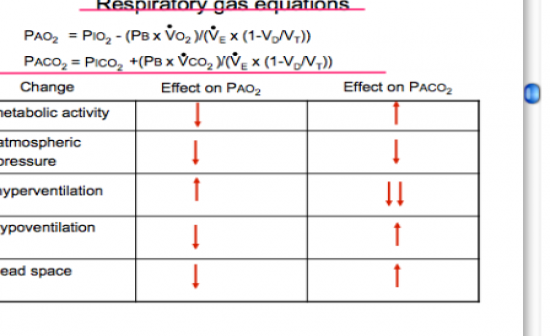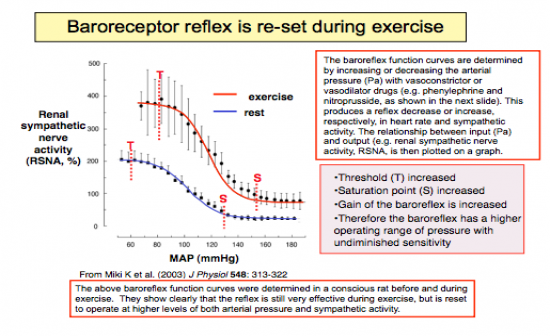Cards In This Set
| Front | Back |
|
What are the two halves of circulation and what are their main function?
|
 Systemic Circulation: (Left ventrical --> Right Atrium) Carries oxygenated blood away from the heart to the body, and returns deoxygenated blood back to the heart. Pulmonary Circulation: (Right Ventrical --> Left Atrium). Carriesoxygen-depleted blood away from the heart, to the lungs, and returns oxygenated (oxygen-rich) blood back to the heart. |
|
What part of the circulatory system can create great resistance to flow? When would this action be needed?
|
Arterioles: Has great variation in diameter due to their muscular walls, and are the primary site of vascular resistance.
Exercise: To increase bood flow to skeletal muscle via vasodilation (decreasing resistance).
|
|
What facrots regulation resistance?
|
Flow = Pressure Gradient + Resistance to flow (Ohms Law)
MAP = Change in pressire
MAP = CO x TPR - Hence if the MAP is maintained failry constant, the blood flow to any muscular bed is deendent only on the vascular resistance (mainly arterial resistance) |
|
What is Tidal Volume (VT)?
|
The amount of air entering (or leaving) the mouth and nose in one breath. = ~.5L
|
|
What is the VO2?
|
The Amount of O2 absorbed into the pulmonary blood/min.
|
|
Why is the partial pressure of O2 in arterial blood closely match the partial pressure of O2 in the Alveoli?
|
Because of extremely rapid exchange of O2.
|
|
How does O2 and CO2 move?
|
Diffusion down pressure/concentration gradient
|
|
How do the tissues get the right supply of O2?
|
Feedback system matches supply to demand bia two mechanisms:
(1) Metabolic regulation of local vascular resistance (2) Maintenance of perfusion pressure (MAP) by feedback control system. |
|
How do changes to:
a) Increased metabolic activity b) Decreased atmospheric pressure c) Hyperventilation d) Hypoventilation e) Increased dead space Effect PO2 and PCO2? |
 |
|
Draw a flow diagram outlining the main response to increased metabolic activity. (6 steps)
|
 |
|
Describe the Baroreflex Pathway?
|
Inputs from receptors which signal changes in blood pressure go to the brain and reflexly influence the activity of sympathetic nerves to the heart and blood vessles.
|
|
Describe the Baroreflex?
|
 The baroreflex or baroreceptor reflex is one of the body's homeostatic mechanisms for maintaining blood pressure (STRETCH SENSITIVE). It provides a negative feedback loop in which an elevated blood pressure reflexively causes heart rate to decrease therefore causing blood pressure to decrease; likewise, decreased blood pressure activates the baroreflex, causing heart rate to increase thus causing an increase in blood pressure. |
|
Which fibre type (myelinated or unmyelinated) have a higher threshold and saturation point?
|
A. Unmyelinated:
Unmyelinated fbres show little adaption when pressure levels are high, and hence making unmyelinated fibres better able to signal sustained long term changes in arterial presure. |
|
What does resetting the baroreflex mean?
|
 The baroreflex can be reset during exercise/sleep, to regulate the arterial pressure around whatever the apropriate pressure requires. Eg during exercise, the curves are shifted to a higher operating range, eg your BP is increased but the baroreceptor re-adjusts/reset around a higher MAP. |
|
What are the two types of atrial receptors and when do they fire?
|
 Type A: Increase their firing rate in response to atrial contraction. Type B: Increase their firing rate in response to atrial filling |



